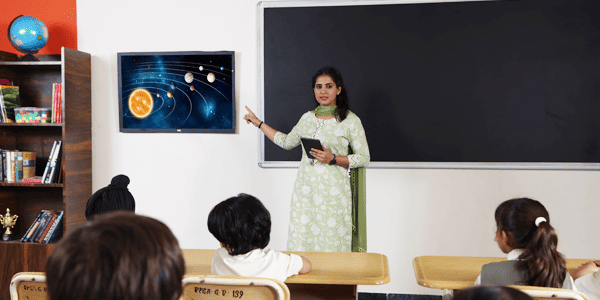Unlock Your Child’s Potential with Primary Science Tuition Singapore
Unlock Your Child’s Potential with Primary Science Tuition Singapore
Blog Article
Checking Out the Different Training Methods in Main Scientific Research Education And Learning Today
The landscape of key science education and learning is progressing, with numerous mentor strategies getting prestige in contemporary classrooms. Inquiry-based learning, hands-on experiments, and the assimilation of innovation are redefining exactly how instructors involve young minds. In addition, joint strategies and differentiated guideline are being employed to accommodate the diverse needs of pupils, improving both interaction and understanding. As we analyze these approaches, questions arise about their effectiveness and the implications for future instructional methods. What might these changes in strategy mean for the next generation of students?
Inquiry-Based Knowing
Inquiry-Based Learning (IBL) is an instructional strategy that encourages trainees to explore scientific ideas with wondering about, investigation, and hands-on testing. This method stresses the duty of students as active individuals in their knowing, advertising crucial reasoning and analytical abilities. By involving with real-world questions, pupils become motivated and curious, which enhances their understanding of scientific concepts.
In IBL, educators act as facilitators, assisting pupils as they navigate their questions instead of supplying information straight. This student-centered approach enables for differentiation, fitting numerous learning styles and speeds. Pupils create abilities in creating theories, designing experiments, and examining information, which are critical for scientific proficiency.
Furthermore, IBL fosters cooperation among students, encouraging them to share searchings for and ideas. This collective inquiry advertises social abilities and a feeling of area within the classroom. In addition, the process of query motivates resilience, as students find out to accept failure as a stepping stone toward understanding.
Hands-On Experiments
Hands-on experiments are a vital component of effective science education, enhancing the principles of inquiry-based discovering. These experiments permit trainees to involve straight with scientific concepts, promoting a much deeper understanding through experiential knowing. By manipulating materials and observing results, young students can grasp abstract concepts in tangible means.
Such activities promote crucial thinking and analytical skills, as trainees hypothesize results, conduct experiments, and examine outcomes. This process motivates them to ask inquiries, fine-tune their understanding, and establish a clinical mindset. Hands-on experiments can be customized to varied understanding designs, ensuring that all pupils have the opportunity to engage meaningfully with the content.
Furthermore, hands-on experiments usually motivate collaboration amongst peers, promoting team effort and interaction abilities. Operating in groups enables trainees to share concepts, go over findings, and learn from each other, which boosts their general educational experience.
Including hands-on experiments right into the key science curriculum not only improves the discovering setting but likewise cultivates a long-lasting rate of interest in scientific research. By actively joining their education, pupils are most likely to develop an interest for scientific query that prolongs past the classroom.

Technology Combination
Integrating innovation into main science education and learning has actually become increasingly crucial in cultivating pupil involvement and enhancing learning outcomes. The use of digital devices, such as interactive simulations, virtual labs, and educational software program, provides trainees with chances to check out scientific concepts in cutting-edge means. These resources help with a deeper understanding of intricate subjects by enabling learners to imagine and control variables that would certainly be impractical in a traditional classroom setup.
Furthermore, technology assimilation encourages individualized discovering experiences. Trainees can progress at their own speed, taking another look at tough concepts via multimedia resources, which satisfy different discovering designs. This versatility not just supports specific development but additionally cultivates a feeling of autonomy in students.
In addition, modern technology functions as a bridge to real-world scientific research, linking students with existing research study and expert payments. Access to on-line databases and scientific journals expands trainees' point of views on clinical inquiry and fosters essential believing abilities.
Collaborative Understanding
Joint understanding plays a vital duty in main scientific research education and learning by fostering synergy and communication abilities amongst students. This approach urges students to collaborate, share knowledge, and take part in problem-solving, which enhances their understanding of clinical principles. By participating in team activities, trainees discover to express their concepts, listen to varied viewpoints, and negotiate solutions, all of which are necessary skills in both real-world and scholastic contexts.

Research study indicates that collective knowing can lead to increased motivation and interaction in science topics, as pupils find enjoyment in common experiences (primary science tuition Singapore). Furthermore, this approach prepares trainees for future joint endeavors, outfitting them with the abilities needed for effective teamwork in college and expert atmospheres. Inevitably, accepting collaborative knowing in primary scientific research education can substantially enhance the learning experience and promote a much deeper understanding of scientific query
Separated Instruction

Set apart direction can manifest in various ways, such as differing the content, processes, or items of learning. Teachers might use tiered jobs that give varying degrees of complexity, permitting trainees to work at their corresponding preparedness degrees. Additionally, adaptable organizing methods can help with cooperation amongst students with various capabilities, promoting peer knowing.
Analysis plays a crucial role in this technique, as it educates direction and assists teachers understand each trainee's special requirements. Formative evaluations, such as observations and tests, can guide educators in changing their strategies to improve finding out results. primary science tuition Singapore. Inevitably, by carrying out set apart instruction in key science education and learning, instructors can cultivate a more equitable and effective understanding why not try here setting, empowering all students to reach their complete capacity in comprehending scientific phenomena
Conclusion
In summary, the diverse website link teaching approaches in primary scientific research education and learning, including inquiry-based understanding, hands-on experiments, innovation combination, collaborative understanding, and distinguished instruction, collectively add to a more reliable understanding setting. These techniques promote vital thinking, analytic skills, and a deeper comprehension of clinical concepts. By carrying out these strategies, instructors can develop helpful and appealing classrooms that attend to the diverse demands of pupils, inevitably promoting a long-lasting passion in science and enhancing academic accomplishment.
Inquiry-Based Understanding (IBL) is a pedagogical method that urges students to check out clinical principles with questioning, investigation, and hands-on experimentation.Collaborative learning plays a vital role in key science education by fostering teamwork and communication skills amongst trainees.Study shows that collaborative understanding can lead to boosted inspiration and engagement in scientific research subjects, as students discover satisfaction in shared experiences.In fostering a comprehensive learning setting, set apart guideline emerges as a crucial strategy to suit the diverse demands and abilities of trainees in main science education and learning. Ultimately, by executing set apart instruction in primary science education and learning, instructors can cultivate a more reliable and equitable understanding setting, encouraging all pupils to reach their complete capacity in understanding clinical phenomena.
Report this page